Category: Exhibitions
Croatian Association of Fine Artists in collaboration with the Ministry of Veterans’ Affairs conducts an international visual arts competition The Victim of Vukovar 1991.
The aim of the international visual arts competition The Victim of Vukovar 1991 is to establish a dialogue with contemporary art practices based on the culture of memory and symbolism of war suffering of the city of Vukovar and generate artworks that will be inscribed in the collective memory.
 Photography: Zoran Filipović Zoro
Photography: Zoran Filipović Zoro
The competition will select four new works of art (that have never been presented to the public) to be exhibited in Zagreb in June 2020, on the occasion of the Croatian presidency of the Council of the European Union, after which the exhibition will be held at the Vukovar Municipal Museum until the end of 2020.
The selected artists will receive an artist’s fee of HRK 60,000 gross each. Artists will be provided with return transport of the artworks, insurance, and overnight and travel expenses for participation in the exhibitions.
Competition is open to professional artists, EU Member States citizens, working in the field of visual arts. Artists can apply individually, in pairs or as a part of an art collective. Deadline for submission is 9.4.2020.
Works will be selected by a jury consisting of: Tonko Maroević, academician, Branko Franceschi, art historian, Kristijan Milić, film director, Božica Dea Matasić, full professor of arts, Tomislav Buntak, associate professor of arts, Ana Holjevac Tuković, PhD in History, Mirela Buterin, LLB.
More details on the competition is available HERE.
Questions and answers for the INTERNATIONAL VISUAL ARTS COMPETITION “THE VICTIM OF VUKOVAR 1991 HERE
NOTICE OF TEMPORARY SUSPENSION
of the International Visual Arts Competition
“The Victim of Vukovar 1991“
Due to changes in the economic trends in the Republic of Croatia as a result of the COVID-19 epidemic which have led to the reallocation of funds to measures and activities aimed at combating the epidemic, as well as to changes in the planned budgetary activities to optimize the use of limited fiscal potential, the Ministry of Defence (The Client) has adopted the decision to temporarily suspend the International Visual Arts Competition “The Victim of Vukovar 1991“.
All the competition activities have been postponed until further notice, that is until the funds have been secured and the decision has been made to continue with the competition, about which all the artists who applied to the competition will be notified in a timely manner.
Artists who wish to withdraw their applications due to changes in the competition conditions can do so by sending an email to hdlu@hdlu.hr with the subject Vukovar Competition – Application Withdrawal.
Thank you for your understanding.
PETAR KATAVIĆ
ARCHITECTURE
Karas Gallery
March 9 – March 22, 2020
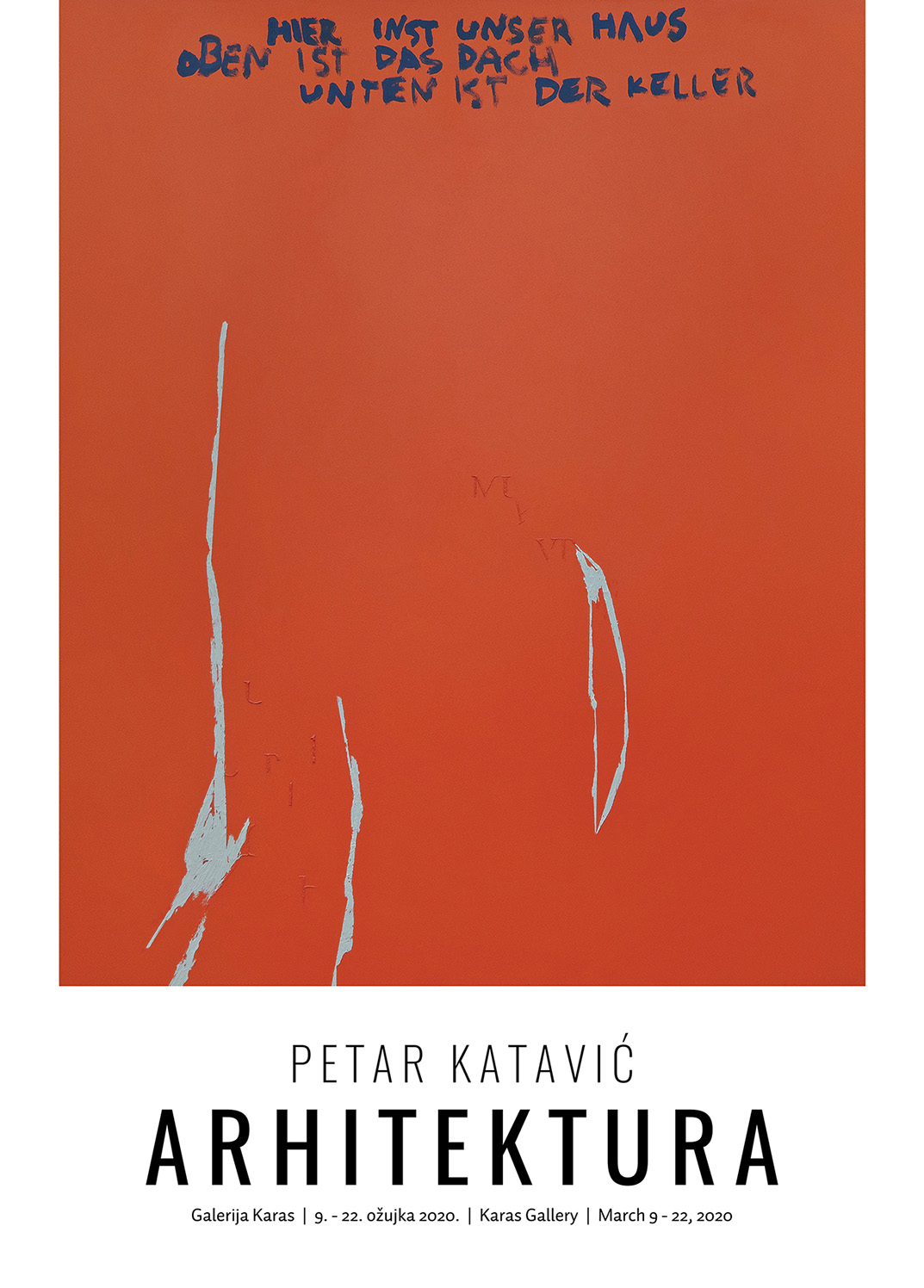
Exhibition Architecture, by Petar Katavić, will be opened on Monday, March 9 at 7 pm at the Karas Gallery (Zvonimirova 58).
“The exhibition presents the work of Petar Katavić, and here selected works are the continuation of the exhibition held at the Museum of Fine Arts in January this year. Since 2017 Petar has been developing and building on his ideas about shaping space with volume, which he also strives to show through his works. The reduction of colour, lines and surfaces, as well as simplicity in thinking about visual art, are the characteristics of the artist’s work, reflected both in the titles of his works and in the exhibition set-up. The exhibition held at the Museum of Fine Arts was titled Space, mostly because it was a site-specific exhibition creating bearing in mind the specific exhibition space within the gallery, and the title of this exhibition – Architecture – is a logical continuation that reveals the focus of the artist’s interests. (…)
(…) Although the aesthetics of Petar’s works is reduced, minimalistic and simple, each work reflects his dedication and devotion, which he sees as the most important factor in his work. In conclusion, I will again, just as in the preface to the Space exhibition, refer to Mies van der Rohe’s famous motto “less is more“, Petar’s guiding principle that very clearly illustrates the subtlety and meditativeness that I find in Petar’s works.”
From preface, written by Ivana Vukušić
ABOUT THE ARTIST
Petar Katavić was born in Split in 1985. In 2005 he graduated Painting at the School of Fine Arts, Split, Croatia. In 2012. he graduated Painting from the Arts Academy, University of Split, Split, Croatia. In 2014 he completed the program of pedagogical-psychological-didactic-methodical education at the Faculty of Humanities and Social Sciences, University of Split, Split, Croatia. He had solo exhibitions in SC Gallery, Zagreb (Surface, 2020), Salon Galić Gallery, Split, Croatia (2019), Museum of Fine Arts, Split, Croatia (2019), Branislav Dešković Gallery of fine arts, Bol, island of Brač, Croatia (2018), Studio 21 Gallery, Split, Croatia (2015), Salon Galić Gallery, Split, Croatia (2014), Museum of Fine Arts, Split, Croatia (2012), and Loggia / Center for Culture and Lifelong Learning ‘Golden Gate’, Split, Croatia (2012). He has also participated in numerous group exhibitions. Note worthily are: Golden watermelon 3,0. Pula, Croatia (2019), 54th Zagreb Salon, Zagreb, Croatia (2019), 40th Split Salon, Split, Croatia (2018), Museum of Fine Arts, Split, Croatia (2017) and 39th Split Salon, Split, Croatia (2015). He is currently an assistant professor in the Department of Painting at the Arts Academy, University of Split.
Organizer:

Supported by:
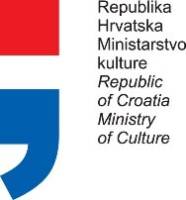

Working hours:
Wednesday – Friday: 3 pm – 8 pm | Saturday: 10 am to 1 pm
Sundays, Mondays, Tuesdays and holidays: closed.
The exhibition will remain open until March 22, 2020
MARGARETA LEKIĆ
THE RUBBER CONCRETE
Karas Gallery
February 11 – February 23, 2020
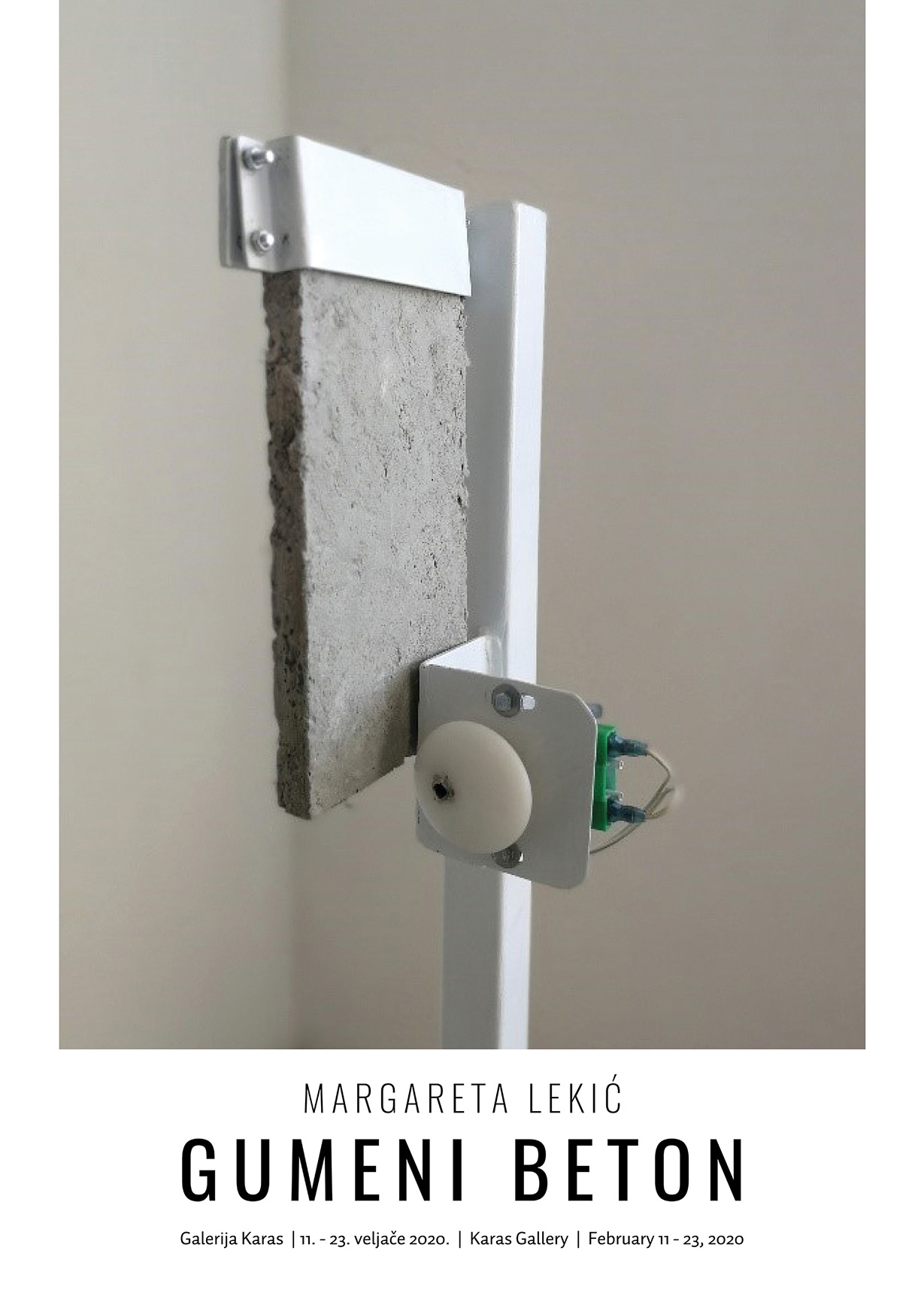
Exhibition The Rubber Concrete, by Margareta Lekić, will be opened on Tuesday, February 11 at 7 pm at the Karas Gallery (Zvonimirova 58). Exhibition is also the public presentation of the artistic part of the doctoral thesis “Redefining Sculpture Using Contemporary Materials” at the Postgraduate Study of the Academy of Fine Arts, University of Zagreb.
Mentors: Prof. Damir Matausic and Ph.D. Margareta Turkalj Podmanicki.
ARTIST STATEMENT
The development of technology and the desire to create new products also result in the creation of new materials. The Gumeni beton (Rubber Concrete) series of works and the new eponymous material were created as a reaction to the inability to access new and innovative solutions in the material manufacturing industry. Searching for an unusually flexible material, I came across a concrete called ConFlexPave, which is rubber under pressure but is not flexible to the extent that it can be restored to its original shape. Since ConFlexPave is not commercially available, I contacted Nanyang Technological University (NTU Singapore), that is, NTU-JTC Industrial Infrastructure Innovation Centre (I³C) to obtain a sample of the concrete for the purposes of my artistic research. I did not get a reply, so I decided to create a new type of material myself, without having any scientific knowledge and expensive laboratory equipment. I created concrete that is rubber in both directions when pressed with hands. However, since I am not a scientist and the material has not been tested in the conditions under which materials are usually tested, I cannot conclude whether this material, a rubber concrete, will be equally flexible even after a certain amount of time has passed. The newly created material, that is, the new type of concrete, has all the characteristics of concrete as a composite material, it consists of cement, gravel, sand, water and additional components that make it flexible.
The Rubber Concrete series of works consists of three sculptures titled Rubber Concrete 1, Rubber Concrete 2 and Rubber Concrete 3. I use the word “rubber” because in everyday language it is common to say that anything flexible is like made of rubber, for example, a physically flexible person is often referred to as “a rubber man“. Therefore, the word “rubber“ in the work’s title does not refer to the physical structure but has a figurative meaning. All three sculptures are in equal proportions, in the correct size ratio. This structure, i.e. the order and correlation in the Rubber Concrete series of works is obvious because all three sculptures are placed in a certain ratio to each other; Rubber Concrete 1 is approximately 40% higher than Rubber Concrete 2, and Rubber Concrete 2 is 40% higher than Rubber Concrete 3. In doing so, I created a proportional relationship, not only between the dimensions of the sculptures but also between the dimensions of concrete slabs. The concrete slab in the work Rubber Concrete 1 is 40% longer and wider than the slab in the work Rubber Concrete 2, and the slab in the work Rubber Concrete 2 is 40% longer and wider than the slab in the work Rubber Concrete 3.
Rubber Concrete 1
– concrete slate: 25x12x1 cm
– sculpture: 140x40x40 cm
Rubber Concrete 2
– concrete slate: 35x17x1,5 cm
– sculpture: 98x48x40 cm
Rubber Concrete 3
– concrete slate: 45x24x2 cm
– sculpture: 70x55x40 cm
Accordingly, a calculation can be made:
SCULPTURE – height extension (h) by 40%
The second sculpture was extended by 40% over the third, i.e.:
h_2=h_3+0.4h_3
h_2=1.4h_3.
Since the first sculpture is 40% higher than the second, the following formula will apply:
h_1=h_2+0.4h_2
h_1=1.4h_2
h_1=1.4∙1.4h_3
h_1=〖1.4〗^2 h_3.
If there were n number of sculptures, formulas to associate their heights with the height of the nth sculpture would read:
h_(n-m) =〖1.4〗^m h_n,
where n is the maximum number of sculptures and m is a growing number of natural numbers.
In particular, if we applied the last mentioned formula to the dimensions of the sculptures in the artwork, it would be:
→for n=3, m=1: h_(3-1)=〖1.4〗^1∙h_3
h_2=1.4∙h_3
h_2=1.4∙70 cm
h_2=98 cm
which is the length of the height of the other sculpture.
The same would be true of the first sculpture as well:
→for n=3, m=2: h_(3-2)=〖1.4〗^2∙h_3
h_1=〖1.4〗^2∙h_3
h_1=〖1.4〗^2∙70 cm
h_2=137.2 cm ≈140 cm
CONCRETE SLABS – height extension by 40% and width extension by 40%
If x denotes the lengths and y the widths of the slabs, then for the 2nd concrete slab which is in relation
to the first one longer by 40% the following formula will apply: x_2=x_1+0.4x_1
x_2=1.4x_1.
For the third slab, which is 40% longer than the second, the following would be true:
x_3=x_2+0.4x_2
x_3=1.4x_2
x_3=1.4∙1.4x_1
x_3=〖1.4〗^2 x_1.
In general: x_n=〖1.4〗^(n-1) x_1,
where n is the number of the concrete slab and x_n the corresponding length of the same slab.
A similar consideration can be applied to the widths of the slabs which we will denote by y, and so for these dimensions a following formula would apply: y_n=〖1.4〗^(n-1) y_1, where n is the number of the concrete slab and y_n the corresponding width of the same slab.
Applying formula to the specified dimensions of concrete slabs in the artwork, we get the following: →for n=2: 〖 x〗_2=1.4∙25 cm=35 cm
〖 y〗_2=1.4∙12 cm=16.8 cm ≈17 cm
→for n=3: 〖 x〗_3=〖1.4〗^2∙25 cm=49 cm
y_3=〖1.4〗^2∙12 cm=23.52 cm ≈24 cm.
ABOUT THE ARTIST
Margareta Lekić was born in Osijek in 1982. She is a member of the Croatian Association of Artists – Osijek and Croatian Association of Artists – Zagreb. She graduated from the Department of Sculpture at the Academy of Fine Arts in Zagreb, where she is currently pursuing her doctoral studies at the same department. She works as an artistic associate at the Academy of Arts and Culture in Osijek. She has won numerous awards and grants. She has studied in the USA, Austria and France. Since 2005 she has had 22 solo exhibitions and has participated in 55 group exhibitions. Margareta has exhibited in Croatia, Europe, the USA, Japan and China.
Organizers:


Supported by:

Working hours:
Wednesday – Friday: 3 pm – 8 pm | Saturday: 10 am to 1 pm
Sundays, Mondays, Tuesdays and holidays: closed.
The exhibition will remain open until February 23, 2020
A Game of Sports and Art – Towards a permanent exhibition of the Croatian Sports Museum
February 6 – March 22
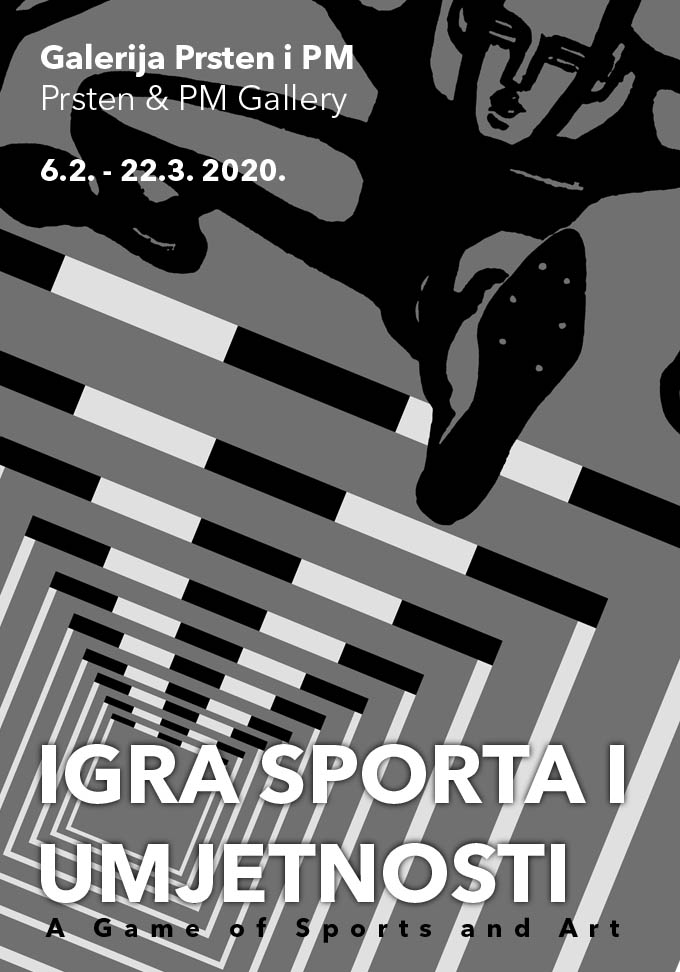
The Croatian Sports Museum, in collaboration with the Croatian Association of Artists and the Academy of Fine Arts from Zagreb, presents a comprehensive exhibition project titled A Game of Sports and Art that announces the permanent exhibition of the Croatian Sports Museum.
Through the exhibition in two parts, the Home of the Croatian Association of Artists becomes a meeting place for sports, education, culture and art, which testifies to the connection between art and sports.
The first part of the exhibition shows the development of applied arts in the field of sports since the beginning of organized sports in Croatia, whereas the second part of the exhibition presents sports as a profession and widespread healthy recreational activity, as well as inspiration for the creation of artworks by contemporary artists.
The exhibition features a wide range of exhibits – from museum ones, which combine traces of history and tell the story of the development of sports, to artworks that comment, describe personal experiences and speak of the possible combinations between various creative sports games and art.
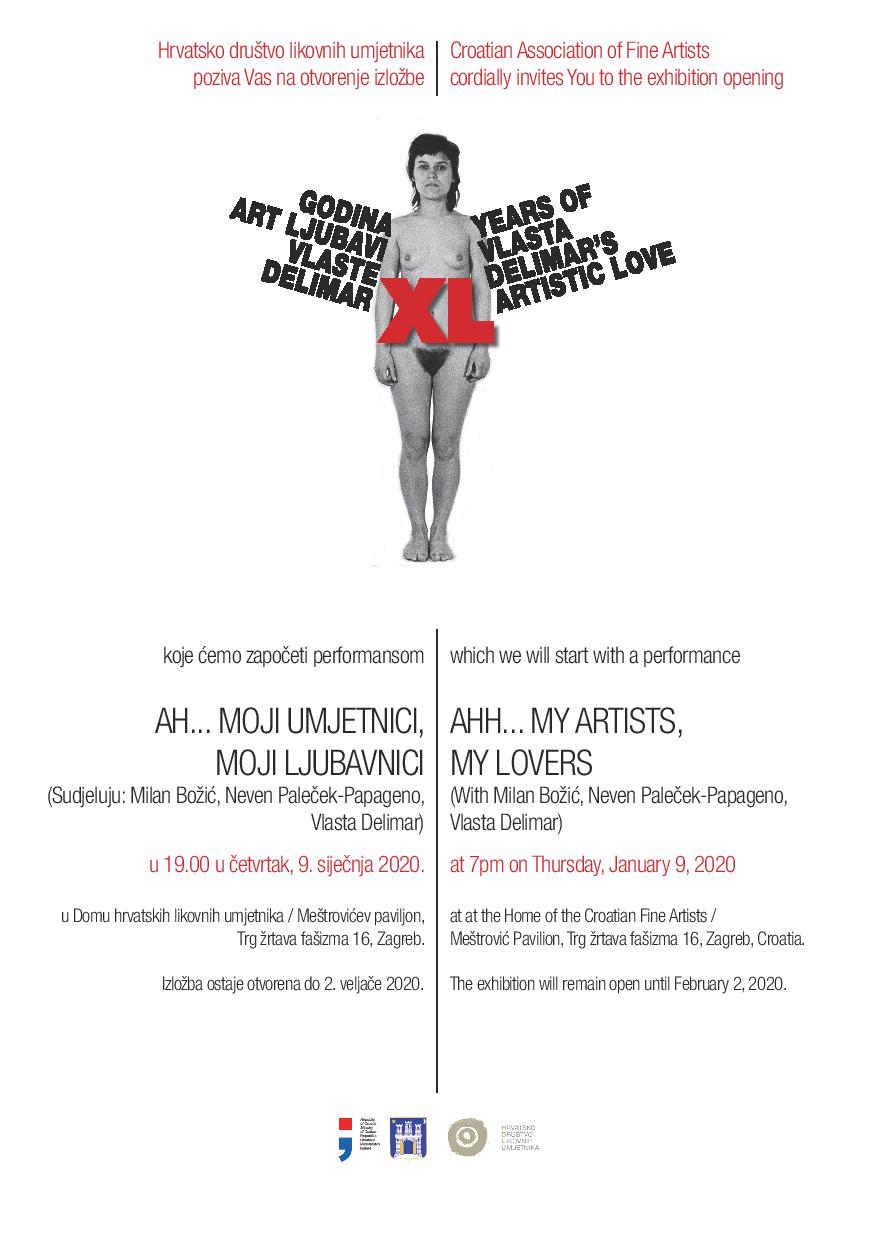
Vlasta Delimar’s first solo performance took place in 1980, no less than forty years ago. On that occasion, at the Zagreb Student Centre Gallery, she performed a piece entitled Transformation of Personality (through Clothes, Make-Up and Hairdo), affirming her body as the most prominent medium of her art practice, in which she persists to this day. By examining the possibility of changing her appearance through a simple change of clothes, Delimar begins the exploration of laying oneself bare as the only true representation of one’s identity with a pronounced critical attitude towards bourgeois morality and the aversion to the naked body. It is not rare for her practice to be inseparable from life, which underscores the complete synergy between artistic creation and living. As an artist, a woman and a mother, Delimar entwines conventional roles with subversive departures from them, erasing the limits that constrain the heteronormative view of the female body, identity and existence.
Thanks to her performance art, Delimar came to be considered one of the key figures in the performative art practice in the contemporary Croatian art scene. Even though she is now recognized as one of the key figures in Croatian body art, there was a time when neither the audience nor the relevant institutions recognized her artistic endeavours. Delimar’s return to the Croatian Association of Visual Artists (HDLU) is symbolic since her application for membership was denied in 1982 with a note that her art degraded female dignity. However, by persisting in her exploration of the poetry of the body, which is at once intimist and exhibitionist, Delimar has opened the door for an unrestricted expression of repressed female sexuality, the representation of which has changed throughout the years, although the artist has never lost her authenticity.
Vlasta Delimar’s artistic career can be traced as far back as the seventies, which were marked by her collaborations with the Group of Six Authors, mostly with Željko Jerman. As an unofficial member of the group, Delimar claims to have developed the so-called elementary body as her medium, parallel to Jerman’s elementary photography, Demur’s elementary painting and Martek’s elementary poetry. She first took to the stage in a collaborative performance piece entitled An Attempt at Identification, which was performed in 1979 at the iconic Podroom Gallery in Zagreb. A hand-made performance announcement read, “The performance piece we intended to perform at the opening of the ‘Youth Salon’ will be performed at ‘Podrum’, 12 Mesnička Street, on Monday, 19 November 1979, at 8 pm.”, which put an emphasis on the lack of understanding for this form of artistic practice exhibited by the institutionalized culture of the time. In their collaborative piece, Jerman and Delimar foregrounded two aspects of approaching the existential: while the first one referred to a self-analysis of mutual relationships, departing from a personal egocentrism and establishing one’s “self” in order to build on it by developing a sense of community, the second one amounted to a critique of social conventions.
Forty years later, Delimar performed the piece again at the Mesnička Culture Centre, this time in collaboration with the audience, as a way of marking the beginning of the celebration of her long-time exploration of the body, intimacy, social environments and human relationships through provocative and striking performance art. Even though it was not rare for her to collaborate with other artists, Delimar has always put an emphasis on the affirmation of her own identity and individuality by using her body as a metaphorical representation of an identity laid bare. The fact that she has proudly used and presented her own body as a living sculpture, changing from year to year, in spite of, or even contrary to, socially and traditionally accepted standards is one of the things that make her an artist that has truly left a mark on history.
In the jubilee year of 2020, the artist returns to the venue of her first solo exhibition (1981) – the Home of the Croatian Fine Artists. The exhibition consists of forty black-and-white photographs that form a spatial installation and imitate an analogue camera film. The decision to print the photographs in black and white was influenced by a romantic sentiment, the fact that the artist started her career by making black-and-white photographs, which therefore bear a great, intimate significance. Opting for such a cyclical display, Delimar guides the observer through the tape of her life imbued with her artwork, which starts and ends in a passage, acting as both the entry to and exit from the gallery, preventing the circle from closing and leaving a symbolic space open for future artistic exploration. The retrospective venue therefore becomes a space marked by the possibility of extension, inscription and continuation.
The performance piece Ahh… My Artists, My Lovers, realized in collaboration with Milan Božić and the opera singer Neven Paleček Papageno, was created when the texts Delimar created in the memory of the artists through conversations, gatherings and experiences with whom she created her own performance art were set to music. Due to the specific spatial acoustics of the Bačva Gallery, verses dedicated to each of Delimar’s life companions resound accompanied by the echo of a male baritone voice, producing a near ritual atmosphere that reifies the bitter-sweet memories of closeness, loss and creation.
These histories are personal inasmuch as the artists in question have mutually shaped each other’s stories, but they also outline the elaboration of artistic practices these artists tailored together. Here, Delimar really emerges as an artist, friend and lover – her life is truly one with her work that now spans more than forty years. In the performance itself, it should be noted, she introduces a third person, a third voice, that of the opera singer who reflects on the past on her behalf: at this moment, the artist, whose own body is above all else a medium, gives a voice to someone else, a male baritone, in memory of those complex, multifaceted relationships.
Taken together, the exhibition and the performance piece represent the complexity of history, as well as the retrospective collection and contemplation of defining moments. Here, the photographic film serves as a tool not only for documenting one’s own practice, but also for redefining the meaning of that practice in both the personal and creative sense, as well as in relation to others. The same film is open to modification, new inscriptions and supplementation – it remains open forever. At the same time, sang as a part of the piece, the memories of friends and colleagues with whom Delimar produced her artwork are given enough space to come back to life in the full strength of emotion – the medium of performance art itself, the medium of performance, emphasizes the momentariness of all the minute moments in history, which go away, but, at the same time, stay forever.
An overview of Vlasta Delimar’s career spanning four decades entitled Forty Years of Vlasta Delimar’s Artistic Love will be displayed in cities throughout former Yugoslavia (Ljubljana, Zagreb, Rijeka, Sarajevo, Novi Sad, Belgrade, Podgorica, Skopje) in 2020.
Biography:
Vlasta Delimar (1956 Zagreb) is the most significant Croatian performer, uncompromising in criticism of society. In 1986 she received the Seven Secretary of the Young Communist League of Yugoslavia Award (Nagrada Sedam sekretara SKOJ-a). From 2005 to 2015 she was the head of the artistic organisation My Country Štaglinec and of the performance program of the festival held in Štaglinec near Koprivnica. She is the key figure in the portrayal of performance through the prism of her own body and the content of the female, the naked body, which in today’s society is still subject to controversy. Through her work, she explores femininity, male-female relationships and life cycles from youth and longing through partnership and motherhood to ageing. She introduces autobiographical narratives into the public space, questioning the demarcation of public and private and the norms of identity politics.
THE DE/CONSTRUCTION OF THE PAINTING
Karas Gallery
November 5 – December 8, 2019
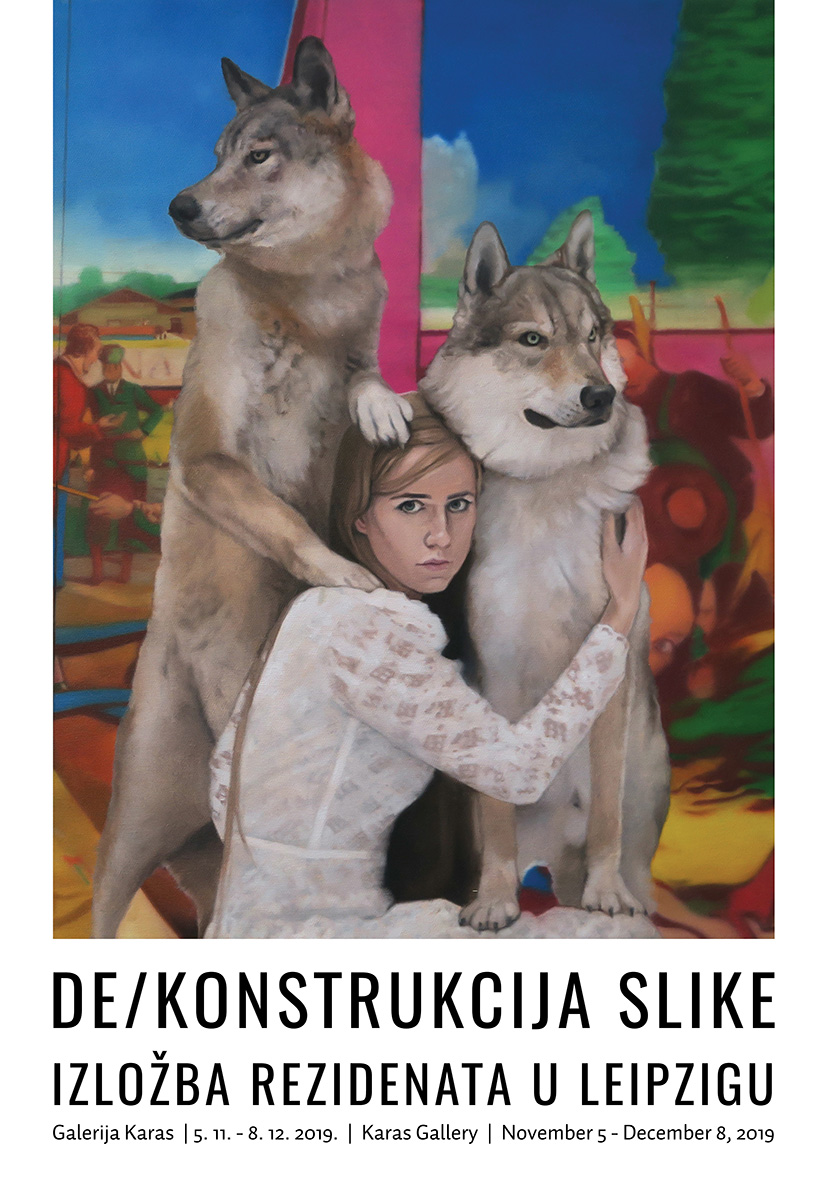
Exhibition The De/construction of the Painting, by Croatian artists/residents in Leipzig, will be opened on Tuesday, November 5 at 7 pm at the Karas Gallery (Zvonimirova 58).
Artists:
Miran Blažek, Martina Grlić, Petra Grozaj, Nenad Jalšovec, Helena Janečić, Marija Koruga, Velibor Mačukatin Lav Paripović, Pavle Pavlović, Ivan Prerad, Ana Ratković Sobota, Marijan Richter, Maja Rožman, Damir Sobota, Stjepan Šandrk, Alma Trtovac
Preface in Croatian and German
Organizer:


Supported by:

Working hours:
Wednesday – Friday: 3 pm – 8 pm | Saturday and Sunday: 10 am to 1 pm
Mondays, Tuesdays and holidays: closed.
The exhibition will remain open until December 8, 2019
DOMAGOJ ROGINA
FROM THE SHADOW
Karas Gallery
October 15 – October 27, 2019

Opening of the exhibition: Tuesday, October 15 at 7 pm at the Karas Gallery
Exhibition From the Shadow, by Domagoj Rogina, will be opened on Tuesday, October 15 at 7 pm at the Karas Gallery (Zvonimirova 58).
“The From the Shadow Cycle of Domagoj Rogina is a cycle of still life in undefined, non-geographic spaces in which spreads of solid masses of teapots break through the layers, on sunny days, strands of toothed mountain peaks show one after another, and the cat’s soft-eared heads open their large jaws under the indifferent condemnation of shadowy lying kittens. The title (From the Shadow) stems spontaneously from the atmosphere of the cramped atelier in which the artist creates the attic and the sound of the occasional train, but also the elements of separation from the roaring world outside, in the face of separation from the safe situations of the artist on the Academy. For the idea of an artist as a hermetic who creates metaphorical gold in his alchemical laboratory of lead surrounding him is a wonderful story told by centuries-old annals of populist characterization of an artistic personality, but in reality, it is a constant conflict with the material demands of everyday life and himself. In this sense, Rogina’s paintings are filled with inner turmoil through the alternations of night and day, smooth and rugged, shiny and matte, cool and warm, light and shade. And precisely the heavy shadow, the element of material construction, becomes a place of conflict, becomes a being, as lively and important as other motives, in the rhythmic alternation of concentration – chaos – concentration – chaos, in the form of a dream (or nightmare) and a dark gap at the legs of the wrapped shape.”
From the preface, written by Marija Kamber
ABOUT THE ARTIST
Domagoj Rogina was born in Varaždin in 1989. In 2017 he graduated in Painting from the Department of Art Education, Academy of Fine Arts in Zagreb, in the class of prof. Damir Sokić. So far, he has exhibited in thirty group exhibitions like 32nd Youth Salon, 4th and 5th Biennial of Painting and 13th and 15th Erste Fragments, to name a few. He had solo exhibitions in 3.14 Gallery, Vladimir Filakovac Gallery, Greta Gallery and SC Gallery. He participated on an art residency in Belgium in 2015 and in the 2019 in fine art colony of Počitelj (BiH). He has received 0 awards for his work so far. Since 2018 he has been working as a professor of fine arts and technical culture at the Slava Raškaj Education Center in Zagreb.
Phone: 099 501 8068
Organizer:


Supported by:

![]()
Working hours:
Wednesday – Friday: 3 pm – 8 pm | Saturday and Sunday: 10 am to 1 pm
Mondays, Tuesdays and holidays: closed.
The exhibition will remain open until October 27, 2019



